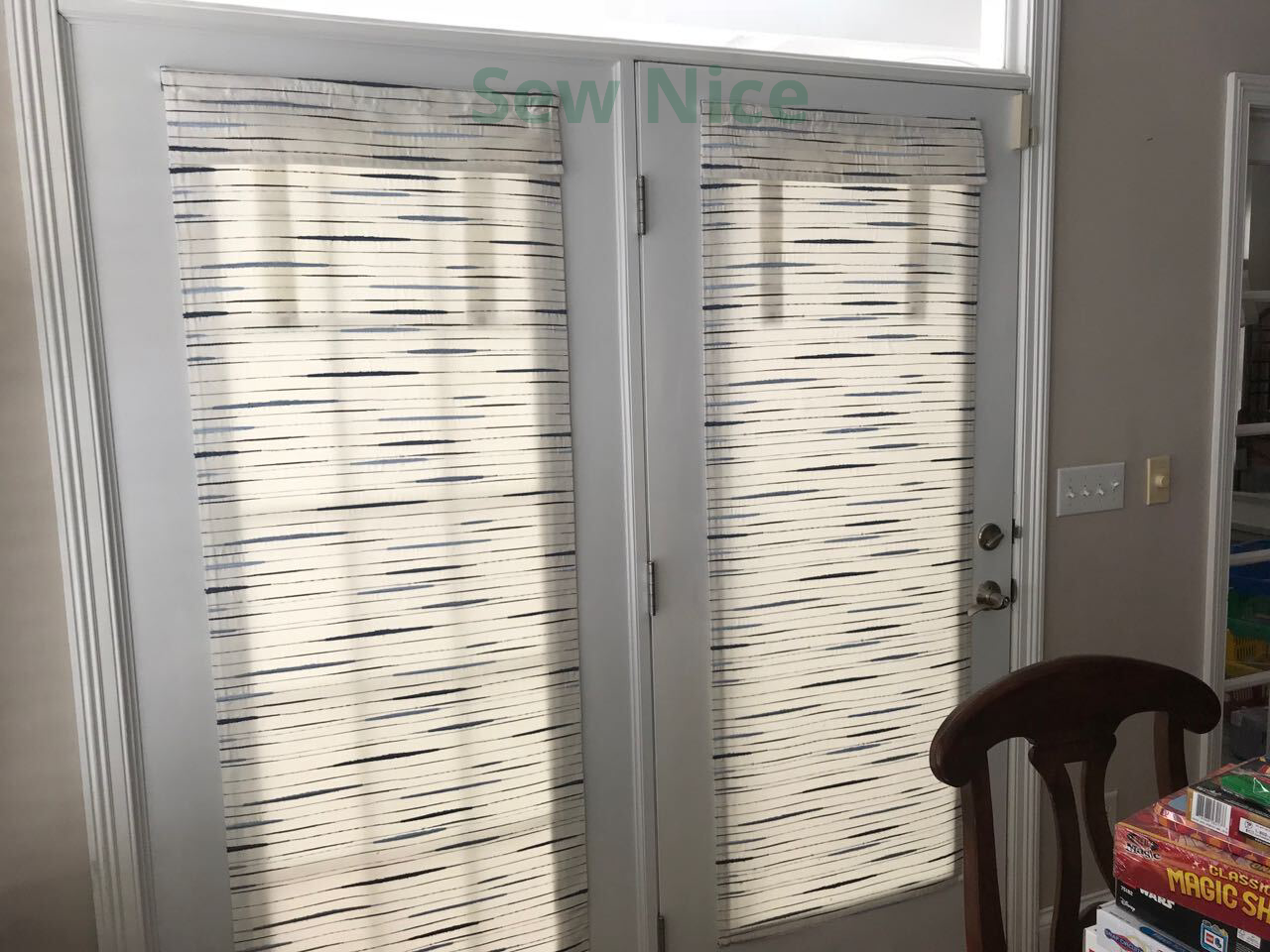Privacy Please! Covering Doors and Entryways
Grand Opening, Soft Opening, Season Opener, Opening day
Used here, the word open or opening refers to something new.
Definition: o*pen*ing, noun 1. An aperture or gap, especially allowing access. 2. A beginning; an initial part.
What better way to begin this year’s blog posts than to write about openings - doors and entryways specifically.
I’ve made many treatments for sliding glass doors, French doors and sidelights, but the number of requests for door coverings last year alone surprised me! Now that people have been spending more time at home than ever before, they are realizing a need for more privacy.
I'll be describing different types of window coverings (also suitable for doors) and on which doors they work best.
Roman Shades
Roman shades are timeless treatments that looks great on doors as well as windows. Depending on the lift system used, Roman shades can have a very small profile, or projection, which won't limit how the door opens. They can raise top to bottom, or drop down from the top in order to allow light but provide privacy. These work well on double or single French doors that are hinged, stationary glass panels, and solid doors that have glass on the top half.
Roman shades on French doors provide privacy when closed.
When open, the top down roman shades still provide privacy.
Roll Up Panels
A roll up panel is a flat panel that is rolled up manually and secured by tabs. These look best when used with a stiff fabric or lined with black out lining to prevent sagging between the tabs when raised. The tabs are typically spaced less than 15" apart, hang from the back of the panel, and secure to the top hook and loop tape. This treatment works well on narrow openings, up to 24" wide. Not recommended for openings wider than 24" as it would cumbersome to secure more than two tabs.
Roll up panels when closed. Tabs on the back are visible. Small, strong magnets are at the bottom so the panel stays secure to the metal door.
Roll up panel in the raised position. Panel is lined with black out lining to provide support between the tabs.
Portiere Panels
Most commonly used for doorless entries. Think of a room that exits into a hallway or two rooms that are connected by a large opening. The term Portiere comes from the French word for door, Porte. This treatment is a drapery panel that is hung over the doorway and is pulled back to one side when it's opened. As it can be viewed from both sides, the panel has decorative fabric on both sides.
This Portiere panel helps provide a level of privacy while remaining open. It adds a decorative element to both the office and the hallway leading to the kitchen. Designed by Ellie Kaplan Interiors.
Close up of the top of the panel shows how it is hung on both sides of the doorway and has the same fabric on both sides. This type of panel really shows off the trim that runs from top to bottom.
Shirred Panels on Rods
Also referred to as rod pocket top and bottom panels. While you may not be familiar with the term, I'm sure you've seen them. This panel is a sheer fabric with casings on both the top and bottom, then installed so that the panel is pulled taut over the glass opening and remains stationary. Sheer fabric becomes more opaque when gathered, providing a level of privacy while still allowing light in. When the panel is pulled in at the center and held with a band, it is called an Hourglass Panel, also stationary. This treatment is used on sidelights (glass panes next to doors), doors that have glass on the top half, and French doors.
Sheer fabric gathered to three times fullness adds enough opacity to provide privacy while still allowing light in.
Entry way doors with glass without the panels.
Solar Screens
Solar screens are very common in restaurants and offices and are gaining popularity in residential use. Sleek and contemporary, they cut down on heat transfer and block damaging UV rays. Solar screen shades are available in wide range of colors and patterns. These are especially great if you need privacy or want to block glare, but still want to be able to enjoy the view outside.
Genesis shades from Lafayette Interior Fashions provide privacy when needed for the doors and windows of these offices.
A set of Genesis Shades from Lafayette Interior Fashions on office doors and windows. Shades shown raised.
Solar screens in a west facing window prevent the glare of afternoon sun, but the view outside is still visible.
Vertical Blinds
Vertical blinds have clean, sleek lines that look great in contemporary as well as traditional settings. When open, they have a small stack size which means they don't take up a lot of room. Like the look of sheers but need more privacy or light control? Sheer Visions from Lafayette Interior Fashions combines the look of a sheer panel with the function of blinds. Vertical blinds are perfect for large door and window openings and sliding glass doors.
Vertical blinds are a classic treatment that look good in any setting. While closed, the slats can be turned to allow light in while still maintaining privacy.
Photography courtesy of Lafayette Interior Fashions
Wrapping the vanes with sheer fabric adds softness to the blinds.
Photography courtesy of Lafayette Interior Fashions.
Cellular Shades
Also referred to as honeycomb shades, these shades have a low profile and, like Roman shades, can open from the top or the bottom, or both. Available in a wide range of colors and styles, cell shades are also available as room dimming. These shades work well on French doors, stationary glass panels, and half glass doors.
Parasol cell shades from Lafayette Interior Fashions help with privacy while filtering daylight when closed. These shades work well on both the door and the two side panels.
When open, cell shades completely clear the window. They have a small projection, so they don't hinder the door from opening.
These are only a few option. There are more possibilities available for doors and openings. Not sure what you want or what will work best on your door or doorway? Contact me for a discovery call and I can help you find the perfect solution for your needs.
Until next time,
Laura
















